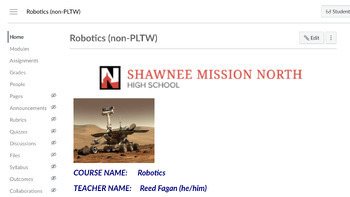Full Year High-School Robotics Curriculum - Fagan 22-23

What educators are saying
Description
This is a Canvas course I have designed to teach high school students Robotics from no knowledge to competing with student-built and programmed bots in roughly a semester's time, with an additional semester for new robots and new competitions/challenges to refine their skills.
A lot of the content draws on VEX and Carnegie Mellon's free educational robotics content and videos. The course was developed using the VEX EDR ("Legacy"/Cortex) system but should translate to the newer V5 system as far as programming and building basics. REV kits (more FTC-oriented robotics) could be used as well; however, some of the programming lessons would simply not apply.
To be clear, vr.vex.com has embedded tutorial videos which are fairly comprehensive on their own if you want to check those out before acquiring this curriculum. However, this Canvas course includes, after intro programming modules, modules dedicated to preparing students for particular past VEX and FTC competitions, specifically, In The Zone and Star Struck (VEX), and SKYSTONE and Freight Frenzy (FTC). All the manuals, rules are already linked in those modules.
Additionally the modules are meant to guide the students in their creation of the most purposeful and successful bots they can create for those competitions, which could be run simply in class, or, as I have done, with other nearby schools' Robotics classes. Rubrics are included along the way to take the subjectivity and time-consuming deliberation out of grading.
The best things about this course:
- Unique modules I am most excited to share here are as follows: virtual Clawbot creation; a dancing robot project; and, a module titled "The Unknown".
- The virtual Clawbot creation exposes students to the world of CAD robot design and assembly. Using Fusion 360 or Inventor, lessons referencing my YouTube videos walk students all the way through creating a Legacy VEX Clawbot (TM) from the individual part files. At the end, successful student should have virtual robots that move their drivetrain and arms in harmony, and even an mp4 rendering of such. That module should take students a full 9 weeks in class to complete. (The YouTube videos are pretty thorough; I created them during the initial COVID-19 lockdown.)
- The dancing robot project is an alternative programming culminating assignment. Using vr.vex.com, the assignment calls for students to make a virtual robot dance to 30 seconds of a song! Multiple examples, of both real and virtual dancing robots, are included, as is a rubric. (This assignment would take anywhere from 1 to 2 weeks in-class.)
- "The Unknown" module provides a framework for those more highly motivated students or classes to choose a problem they want to solve robotically and guides them to plan how they will go from problem definition to final product over anywhere from 2-3 to 5-6 weeks of in-class time. I have had students create robots that explored (with video footage!) drain pipes for a certain distance or a robot to climb a ladder. You might be surprised what your students can come up with at the end of teaching this course!
- Rubrics for everything! Thorough rubrics have been created to evaluate the vast majority of the published assignments here, taking the subjectivity - and time-consuming deliberation - out of your grading. Additionally, for the virtual programming unit which traditionally can take A Lot of checking in by the teacher, a Google Sheet which could be copied is shown that speeds that evaluating process up.
- Examples! Some assignments have screenshots or linked files showing teacher- or student-made examples of what the student should be creating. Some even include a filled-in rubric evaluating the example.
- Pacing guide! A linked Google Sheet shows a plan for teaching the included content over a full school year of time. As a heads-up, I have taught Robotics for 6 years and every year has looked very different from the year prior. The pacing guide ("Year-At-A-Glance") is for my most recent year teaching the course, but there are modules included here which represent previous year's teaching.
Currently the modules are ordered such:
- Essential reference module at top.
- Most recently taught content modules next, in reverse learning order (module at top was taught as last module for the year).
- Unused content modules following, ready for use, later use or deletion.
- Additional reference module.
- Emergency sub plan idea (lesson found online from different source).
As a reminder, this is a Canvas course export file (.imscc). Ignore TPT's label about using it on Google Drive - that's just how I'll share it with you upfront. To my knowledge, anyone can use the free version of Canvas and could thus upload this file to that site. Fair warning, it is a giant file - 188MB (the PLTW version is 220MB - more on that below).
What you purchase here is access to a Google Doc telling you how to contact me for the Canvas file share link. After I've confirmed you've indeed made the purchase on TPT I will grant access to the Canvas file only to the Google address from which you made the request.
For PLTW Engineering teachers, particularly of IED and/or POE: I can also share access to a version of the course that includes some PLTW links and material. Directions for that will be on the Google Doc. Again, this file is larger (220MB).
I hope you find this curriculum, or at least parts of it, useful and look forward to hearing how you use any of it for your class!





